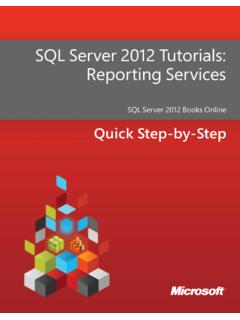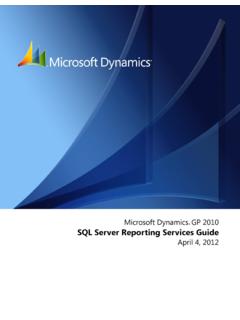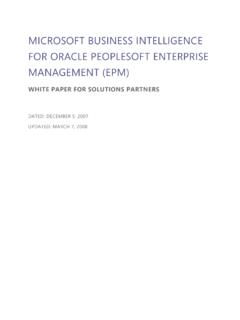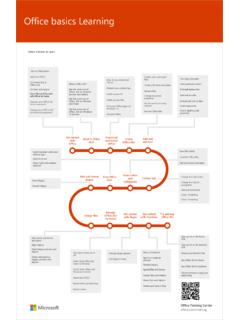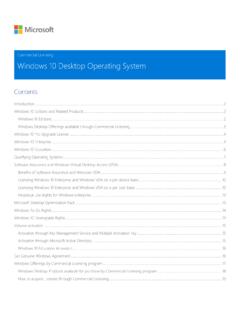Transcription of Microsoft Skype for The Skype for Business Online, on ...
1 2016 Microsoft Corporation. All rights reserved. To send feedback about this documentation, please write to us at Skype for Business Online, on-premises, and hybrid configurations that BDMs and architects need to know aboutMicrosoft Skype for Business Architectural ModelsIntroduction to Skype for Business Architectural ModelsThis series is intended for the IT Pro audience to raise awareness of the different fundamental architectural models through which Skype for Business Online and Skype for Business on premises can be consumed. Start with whichever configuration best suits your organization s needs and future plans. Consider and use others as needed. For example, you might want to consider integration with Exchange and SharePoint or a solution that takes advantage of Microsoft s Cloud PBX informationThree Architectural Models Skype for Business Online You consume Skype for Business through a Software as a Service (SaaS) subscription model.
2 Microsoft hosts your user accounts and manages your Skype for Business infrastructure. You can take advantage of Microsoft s cloud-hosted Private Branch Exchange (PBX) offerings and Public Switched Telephone Network (PSTN) Calling service. Skype for Business on premises You plan, deploy, maintain and customize your Skype for Business environment in a datacenter that you governance &rights managementIT ResponsibilitySkype for Business OnlineHybridOn pre misesClient endpointsAccount & access managementIdentity and directory infrastructureNetwork controlsApplicationsCustomerMicrosoftIT responsibilitiesSkype for Business provides a rich set of capabilities no matter how you architect your deployment. The architecture you choose will determine which IT responsibilities you own, and which you pay Microsoft to support through your subscription.
3 No matter which architecture is best for your organization, there are five core responsibilities that you will always own: Networking an d connectivity Ensure network capacity and availability through firewalls, proxy servers, gateways, and across WAN links by performing a network assessment or by contracting with a partner to do the assessment. Data governan ce & rights man agement Classify your sensitive data and ensure it is protected and monitored wherever it is stored and while it is in transit. Client Endpoints Establish, measure, and enforce modern security standards on devices that are used to access your data and assets. Account & access management Establish a profile for normal account activity and alert on unusual activity. Identity - Use credentials secured by hardware or Multi-Factor Authentication (MFA) for all identities.
4 Microsoft cloud IT architecture cloud ide ntity for enterprise your organization ready for Office 365 topic is 1 of 6 in a series123456 Skype for Business hybrid solutions You combine a Skype for Business Online subscription with your on-premises Skype for Business offering. You can incorporate Skype for Business Online services into your overall Skype for Business offering, start building SaaS management skills in your organization, and move your Skype for Business users to the cloud at your own pace. You can take advantage of Cloud PBX for your users who are homed online while retaining your on-premises PSTN systemPhysical networkPhysical datacenterPhysical hosts 2016 Microsoft Corporation. All rights reserved. To send feedback about this documentation, please write to us at Microsoft host your user accounts and manage your Skype for Business Skype for Business Online, on-premises, and hybrid configurations that BDMs and architects need to know aboutMicrosoft Skype for Business Architectural ModelsSkype for Business OnlineOverview Communication capabilities of Skype for Business Server as a cloud-based service.
5 Software as a Service (SaaS); rich feature set is always up to date. Microsoft hosts and manages the IT infrastructure; you manage your information and users. No operational burden of Skype for Business on-premises servers or server software. Includes a Microsoft Azure Active Directory tenant. Client communication over the Internet is encrypted and authenticated. Take advantage of Microsoft -hosted Cloud PBX functionality. Public switched telephone network (PSTN) connectivity available through Microsoft PSTN Calling service or third-party providers (check availability for your area). Take advantage of Skype Meeting Broadcast. Take advantage of PSTN efficiency and optimize for cost with Office 365 multitenant plans Take advantage of the reliable and flexible Unified Communications enabled by the Microsoft Cloud. simplify communications infrastructure, rollout, and adoption.
6 Reduce your IT costs and free up IT resources. Reduce the cost of infrastructure and hardware. Automatic patching and rapid upgrade to new features. Great for geographically-dispersed organizations or organizations with primarily mobile tasks Ensure network capacity and availability through firewalls, proxy servers, gateways, and across WAN links by performing a network assessment or by contracting with a partner to do the assessment. Acquire third-party SSL certificates to provide enterprise-security for Office 365 service offerings. Decide if you want to connect to Office 365 with Internet Protocol version 6 (IPv6). If you have an existing on-premises directory, determine your directory integration and synchronization requirements. Ensure you have a Microsoft Office 365 tenant with Skype for Business Online enabled.
7 Plan and implement internal and external DNS records and routing. Configure your proxy or firewall for Office 365 IP address and URL requirements. Administer user accounts and Skype for Business Online settings. If you have an existing on-premises directory, implement your directory integration and synchronization Pro tasksLicensing requirements Subscription model, no additional licenses informationOffice 365 admin ove your organization ready for Office 365 Ente up Skype for Business enterprises will have an on-premises directory, which can be integrated and synchronized with the online directory. Office 365 Directory synchronizationActive Directory Domain ServicesSkype for Business OnlineMicrosoft Azure Active Directory TenantMicrosoft AzureOn premisesThis topic is 2 of 6 in a series123456 2016 Microsoft Corporation.
8 All rights reserved. To send feedback about this documentation, please write to us at informationPlan for your Skype for Business Server topic is 4 of 5 in a seriesSkype for Business on premisesThe Skype for Business Online, on-premises, and hybrid configurations that BDMs and architects need to know aboutMicrosoft Skype for Business Architectural ModelsMaintain complete control of your environmentLicensing requirements Server Operating System SQL Server Skype for Business 2015 Server License Skype for Business 2015 Client Access LicenseYou own everythingRequirements for your Skype for Business have control of the platform and the solution, including connecting to the Public Switched Telephone Network (PSTN) and integrating with Private Branch Exchanges (PBXs).Best Highly customized solutions. Legacy solutions with third-party components that depend on hardware and software that are not supported by Skype for Business Online.
9 For example, Survivable Branch Appliance (SBA) configurations. Privacy restrictions that prevent synchronization of Windows Active Directory accounts with Office 365. Organizations that desire control of the entire platform and solution. On-premisesActive Directory Domain ServicesSkype for Business front end poolEdge ServerStorageSkype for Business usersOverview You own everything. Capacity planning and sizing. Server acquisition and setup. Deployment. Scaling out, patching, and operations. Backing up data. Maintaining failover and disaster recovery. Connecting your Skype for Business Server infrastructure to the Public Switched Telephone Network (PSTN). Integration with existing phone equipment, such as Private Branch Exchanges (PBXs). Take advantage of PSTN tasksDesign the Skype for Business environment in an existing on-premises environment: Plan the Skype for Business topology and networking for central and branch offices.
10 Plan for server hardware, including virtualization. Design integration with Windows Server Active Directory and DNS. Plan for load balancing for Skype for Business Server pools. Plan for failover and disaster recovery. IT Pro tasksDeploy and manage the Skype for Business on-premises environment: Provision servers. Deploy the Skype for Business topology. Update Skype for Business servers. Add or remove topology servers as needed based on utilization. Implement the failover and disaster recovery topic is 3 of 6 in a series563214 Skype for Business supports several hybrid configurations, including integrating with Exchange Online and SharePoint Online, and taking advantage of Microsoft Cloud PBX. This diagram shows how you can add Skype for Business Online into your existing on-premises Skype for Business environment, allowing you to move users to the Cloud at your own topic is 3 of 5 in a seriesSkype for Business hybrid configurationsOverview Some users are homed on premises and some users are homed online, but the users share the same Session Initiation Protocol (SIP) domain, such as Take advantage of Microsoft -hosted Cloud PBX functionality for those users who are homed online.



